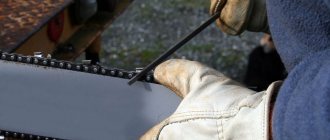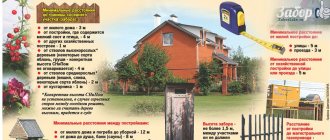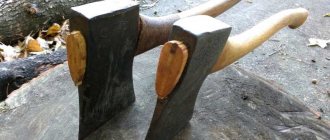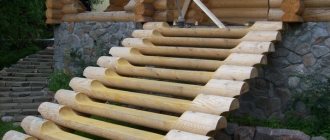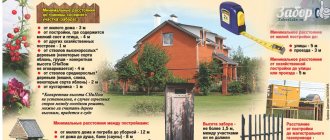When do you need to sharpen a chainsaw chain?
Before you start sharpening, you should figure out when you should do it:
- The cutting time increases, the power decreases;
- The load, the force applied to operate the chainsaw, has increased;
- Small chips, smaller than before, began to fly out;
- The vibration and recoil of the chainsaw have increased;
- The cut shifts to one side if the teeth on a particular one are dull, or to different sides if on both;
- While cutting, smoke comes out from under the wood;
- A noise similar to a grinding sound appears.
A chainsaw chain consists of teeth
Any cutting link has:
- Blades: a) Vertical end; b) Horizontal;
- Sawing (cutting) depth limiter;
- Spatula;
- The basis.
For the saw to perform its function, the blades must be given a specific angle. The back corner of the top blade cuts into the wood, and the end edge cuts the chips.
The end edge and sliding surface form a rake angle of approximately 70 degrees. When sharpening a chain, you need to remember the key rule: the greater the sharpening angle, the more efficient the cutting of soft wood will be. Therefore, the smaller it is, the more dry and rough it is suitable for.
Before sharpening, you need to prepare the chain. To do this, all worn parts are replaced, and the chain itself is cleaned, chips, dust and other debris that can lead to defects are removed.
Also, the chain is tightened a little more than it was before the process. Find the smallest cutting tooth, because during sharpening all other teeth need to be ground down to its level.
There are several methods for sharpening a chain on a chainsaw and are divided into manual and mechanical.
Signs of a dull chain and the consequences of further use
The difficulty of working with a dull chainsaw should not be confused with the difficulty of cutting hardwood or very dry logs. In all these cases, the speed of the operation is reduced, but the blunt instrument has a certain behavior - signs by which one can judge the need for sharpening:
- the chainsaw does not immediately bite into the tree trunk, as if grinding, moving away from the point of contact;
- when cutting soft rocks, the tool sluggishly penetrates the thickness of the wood, you have to put pressure on the bar;
- the shavings from large ones with characteristic oblong particles turn into small thyrsus, which very rarely crumble;
- the chain heats up quickly, an unpleasant smell of burning oil for lubricating the guide bar is heard.
In addition to these alarming signals, always after hitting metal nails, wires with a chain, or burying a chainsaw in the ground, you can be one hundred percent sure of the need for subsequent sharpening of the cutting edges.
What can happen to the instrument in the future if the problem is ignored? The most harmless thing is that it will be impossible to work with a chainsaw; in the end it will get boring and will force you to service the unit. But adherents of the saying “You don’t need intelligence to eat power” can come to the following conclusion:
- extra stress on the body, because, frankly speaking, you have to put pressure on the tool so that it cuts;
- excessive fuel consumption of up to 30%, which is explained by the need to go through a larger revolution cycle to achieve the same result;
- accelerated wear of the tire and other parts of the chainsaw.
In addition to all these negative consequences of a dull saw, there is a high probability of the chain jamming in the barrel and injury to the operator performing the work.
Manual sharpening of chainsaw chain
Sharpening with a file. To work, you will need files with standard sizes 4 (length 200 mm) and 5 (length 250 or 350 mm).
For different types of pitch on the chain, the appropriate files are used:
- 1/4 inch pitch – file diameter 4.0 mm;
- Pitch 0.325 inches - file diameter 4.8 mm;
- 3/8 inch pitch - file diameter 5.2 mm;
- Pitch 0.404 inches - file diameter 5.2 mm.
The process occurs when performing manipulations:
- The tire is clamped in a vice or simply until it is motionless;
- A clamp is put on the file for convenience and to reduce the risk of breaking a tooth;
- Using a clamp with a file at an angle of 25-30 degrees, the teeth are sharpened on the chain with smooth and easy movements;
- The upper edge of the file protrudes beyond the tooth by 1/5 of its diameter;
- Pass the clamp 7 times along the tooth;
- The chain tooth is changed.
The teeth on the other side are sharpened in the same way. For example, we started with the left, which means the saw turns around and the right ones are sharpened. When working with a file, it is recommended to use special templates.
Saw design
To better understand what a chainsaw is and how it works, it is advisable to know how it works.
By the way, it would be more correct to call the cutting tool of a chainsaw a saw chain.
The first saw chains appeared at the beginning of the twentieth century. The designers did not begin to puzzle; they simply mounted teeth on the chain, which quickly lost their functionality. In appearance they resembled those that stand on hand hacksaws for wood. Sharpening such a chainsaw caused great difficulties. But repeated attempts to create the perfect saw chain were crowned with success only in 1947.
Chainsaw device
This chainsaw has links with an L-shaped cut. Modern chains are, in fact, the direct ancestors of this development.
If during work the cutting speed begins to decrease, the chainsaw in the hands of the master begins to “walk”, then most likely the saw chain has lost its operational properties, that is, it has become dull and measures must be taken to restore them.
Sharpening a chainsaw chain using a grinder
- The tire is clamped with a vice;
- The angle grinder (angle grinder) is set at low speed;
- The disk of the machine relative to the tooth is located at an angle of 30 degrees, a slight error is possible;
- Lightly press the tooth with a machine;
- After sharpening, the chain rotates to the next tooth.
During such sharpening, the main thing is to take time so as not to overheat and oversharpen the tooth. It would be more practical to use the method with a file, since there is less chance of making a mistake, however, in the method with a grinder, less time is spent, but extreme precision is also required.
Expert recommendations
There are useful tips for sharpening your chainsaw quickly and efficiently. General recommendations:
- first you need to run in the headset at low speeds, this allows the lubricant to get to each element of the tire;
- the circuit must be energized; loosening may result in injury, especially when using an electric machine;
- It is recommended to edit the headset after each prolonged use of the tool, carefully check the teeth before starting sawing;
- lubricate each element of the tire in a timely manner, which not only improves the process of working with wood, but also reduces the load on the rotor and engine.
The depth of cut, the condition of the cutting edge and the stop must be checked after 3-4 sharpenings. It is recommended to check the template for your specific headset model.
Sharpening a chainsaw chain is an integral part of working with this tool. The sharpness of the teeth affects performance and safety during sawing. To straighten the cutting edge of the tire, you can use an electric or manual machine; at home it is easier to use a file. You should take into account the features of a specific headset model and measure each element with a template.
Sharpening a chainsaw chain on a machine
Sharpening on the machine:
- The chain is installed on a holder with a blocker and fixed on it;
- The horizontal position is set, the angle is 30 degrees;
- The lever adjusts the angle of the grinding wheel;
- A limiter is installed to prevent the possibility of lowering the chain too low and cutting it;
- After finishing sharpening one side, the holder with the chain is turned around and the other is sharpened.
Good sharpening can be determined by the presence of reflection. If it is not there, then the blade is sharp enough and there is no point in continuing to sharpen. Any reflection of light or glare indicates the need to sharpen it sharper.
After sharpening the teeth, you need to adjust the height of the depth stop using a gauge, placing it on top of the chain. When the limiter protrudes beyond the gauge, its height is adjusted with a file. The excess top is ground down to the caliber level.
When sharpening teeth, my own problems may arise, and with them the consequences:
- Very sharp sharpening angle. Consequences: after sharpening during operation, the teeth will experience too much stress and eventually break off, the cut will be aggressive and difficult;
- The front angle is tilted forward. Consequences: high kickback of the saw, reduced wear resistance of the chain;
- Obtuse angle. Consequences: high kickback of the saw, great effort is applied to cut;
- Differences in front angles. Consequences: saw getting stuck in wood;
- Different sharpening angles. Consequences: crooked, uneven cut.
Tips on how to reduce chain and tooth wear:
- The top should be well tensioned;
- Before working with a chainsaw, warm up the teeth for several minutes;
- Carry out timely sharpening;
- Regularly check the lubrication system and the presence of lubricant on parts;
- Store the chainsaw under normal conditions.
When sharpening, especially on a machine, safety precautions must be observed.
Everything should be secured securely so that the chain or saw does not fall out during the process. It is also necessary to take into account all the requirements for sharpening and the order of implementation, force, do it carefully and without sudden movements, so as not to dull or chip off the teeth, without finally breaking the chain itself. Before work, it is worth spending a little time and checking the chain.
What are the dangers of working with a blunt instrument?
The chain of an electric or gasoline saw is designed for sawing hard and soft wood and plastic products. When the tool is used regularly, the chain mechanism becomes dull, which can lead to unpleasant consequences. A worn chain mechanism puts you at risk of breaking individual elements of the entire tool. When sawing with a dull chainsaw, fuel consumption increases.
Additional Information! When using a dull chainsaw, the process of sawing any materials takes longer, and productivity drops noticeably.
To maintain the functionality of the saw for a long time, the chain mechanism should be inspected and sharpened in a timely manner. The check should be carried out between jobs depending on the frequency of use of the tool.
